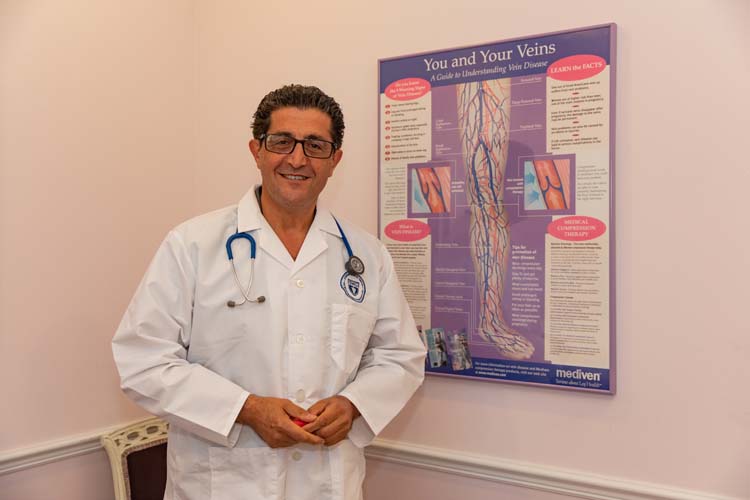
Venous insufficiency, says vascular and endovascular surgeon Dr. Hadi Shalhoub, is “the silent disease.”
That is probably one reason he is so vocal about it. Another is that, by his count, “70 to 80 percent of patients who come into [Sebastian’s] Wound Care Center with a chronic wound come in with a venous insufficiency.”
According to Johns Hopkins Medicine, “venous insufficiency occurs when your leg veins don’t allow blood to flow back up to your heart. Normally, the valves in your veins make sure that blood flows toward your heart. But when these valves don’t work well, blood can also flow backwards. This can cause blood to collect (pool) in your legs. If this condition is not treated, you may have pain, swelling, cramps, skin changes, varicose veins and leg ulcers.”
Or worse.
It’s all about those tiny valves inside your veins, according to Shalhoub, a member of the Steward Medical Group.
If those valves fail, it can – and usually does – cause blood pressure to build up in the legs. That increase in pressure prevents nutrients and oxygen from getting to tissues, causing cells to die and wounds to form.
In a worst-case scenario, your blood, blocked by one of those faulty valves, may thicken into a mass that becomes solid, forming a clot that potentially can travel to one of your lungs and make breathing difficult or even cause death.
The National Institutes of Health points out that fully 10 percent of the U.S. population has some type of vascular problem and ones like venous insufficiency are generally considered to be hereditary. You may have been born with a predisposition for developing it.
Unfortunately, there’s no take-home sphygmomanometer (blood pressure cuff) available to self-diagnose venous insufficiency. To spot the signs of a potential problem, people should look for signs such as small spider veins or “a very visible blood vessel that dilates and shows on somebody’s leg.”
Asked how venous insufficiency is confirmed and treated, Shalhoub says “every patient usually has a full clinical evaluation and we find out whether there are other abnormalities to their vein structure.
Sometimes the heart has to be evaluated also, because if the pump is not working and it causes backup pressure onto the lower veins, that can cause swelling in the legs too, and that has to be understood.”
A key part of this evaluation is a highly specialized form of ultra-sound called a “VNUS Grade Doppler” which, Shalhoub explains, “is designed to visualize all of these valves and grade them to see if they are incompetent.”
If they are, don’t look for Shalhoub to break out his prescription pad. There are, he states, “very few medications” that can successfully treat this particular problem.
Instead, it’s more likely Shalhoub will close-off the malfunctioning vein and valve and allow other nearby veins to take over.
“Once the [damaged] vein is closed, less blood pools in the leg, and overall blood flow is improved,” according to University of Rochester Medical Center.
“We figured out if we close [the veins with malfunctioning valves], they do actually improve the symptoms in the legs,” Shalhoub says.
“The nice thing about this procedure is that it’s an office-based procedure where an ultrasound technician comes and scans the veins and we enter the vein percutaneously with the needle stick, without any sight of blood. I mean it’s like starting an IV. And a catheter is placed inside the vein and monitored under ultrasound for its positioning.
“The catheter,” Shalhoub continues, “is used with radio frequency that generates an amount of heat that brings this vein to a close.”
Pausing, he firmly states, “radio frequency ablation is the superior method of taking care of this problem.”
Dr. Hadi Shalhoub is with Advanced Surgical Associates and the Steward Medical Group. His office is at 13100 U.S. 1 in Sebastian. The phone number is 772-581-8900.



